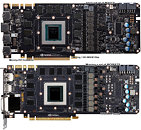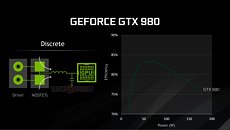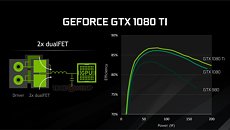Mar 28th, 2025 03:49 EDT
change timezone
Latest GPU Drivers
New Forum Posts
- Is RX 9070 VRAM temperature regular value or hotspot? (244)
- 9070 XT - 2x HDMI high refresh displays (144 and 120 Hz) not working (70)
- TPU's Nostalgic Hardware Club (20135)
- Microprose: Falcon 5.0 - Well under development- yeay (4)
- What are you playing? (23283)
- The TPU UK Clubhouse (25983)
- Post your Speedtest.net Speeds! (2355)
- Smelly brand new graphic cards? Remanufactured? (14)
- Your PC ATM (35294)
- Gigabyte graphic card - TIM GEL application failure? (11)
Popular Reviews
- Sapphire Radeon RX 9070 XT Pulse Review
- Samsung 9100 Pro 2 TB Review - The Best Gen 5 SSD
- Assassin's Creed Shadows Performance Benchmark Review - 30 GPUs Compared
- Pulsar Feinmann F01 Review
- ASRock Phantom Gaming B860I Lightning Wi-Fi Review
- be quiet! Pure Rock Pro 3 Black Review
- Sapphire Radeon RX 9070 XT Nitro+ Review - Beating NVIDIA
- ASRock Radeon RX 9070 XT Taichi OC Review - Excellent Cooling
- AMD Ryzen 7 9800X3D Review - The Best Gaming Processor
- ASUS ProArt X870E-Creator Wi-Fi Review
Controversial News Posts
- AMD RDNA 4 and Radeon RX 9070 Series Unveiled: $549 & $599 (260)
- MSI Doesn't Plan Radeon RX 9000 Series GPUs, Skips AMD RDNA 4 Generation Entirely (142)
- Microsoft Introduces Copilot for Gaming (123)
- AMD Radeon RX 9070 XT Reportedly Outperforms RTX 5080 Through Undervolting (118)
- NVIDIA Reportedly Prepares GeForce RTX 5060 and RTX 5060 Ti Unveil Tomorrow (115)
- Over 200,000 Sold Radeon RX 9070 and RX 9070 XT GPUs? AMD Says No Number was Given (100)
- NVIDIA GeForce RTX 5050, RTX 5060, and RTX 5060 Ti Specifications Leak (96)
- Retailers Anticipate Increased Radeon RX 9070 Series Prices, After Initial Shipments of "MSRP" Models (90)
Monday, March 6th 2017

Reference GeForce GTX 1080 Ti PCB Compared with TITAN X Pascal
Feast your eyes on the first image of a reference NVIDIA GeForce GTX 1080 Ti graphics card, compared side by side with the PCB of the company's flagship (still) TITAN X Pascal. As you can see, the GTX 1080 Ti is based on the same PCB as the TITAN X Pascal, since the two cards are based on the same "GP102" chip (albeit with different core configurations). To begin with, the GTX 1080 Ti features 11 memory chips, compared to 12 on the TITAN X Pascal, on account of its narrower 352-bit GDDR5X memory interface. It makes up for the narrower memory bus with faster 11 Gbps memory chips, than the 10 Gbps chips found on the TITAN X Pascal.
The main difference between the GTX 1080 Ti and TITAN X Pascal, however, is NVIDIA bolstering the VRM with a 2x dual-FET design. NVIDIA basically placed an additional set of MOSFETs and capacitors along all the blank traces of the reference PCB. This approach lowers the load on each individual MOSFET, in turn lowering VRM temperatures. It probably also enables a higher power-limit. NVIDIA also updated the reference design cooling solution with a new vapor-chamber base-plate. The cooler also exhausts through the entire width of the second slot in the card's I/O shield. This meant sacrificing the DVI connector. The GeForce GTX 1080 Ti goes on sale later this month, priced at US $699.
The main difference between the GTX 1080 Ti and TITAN X Pascal, however, is NVIDIA bolstering the VRM with a 2x dual-FET design. NVIDIA basically placed an additional set of MOSFETs and capacitors along all the blank traces of the reference PCB. This approach lowers the load on each individual MOSFET, in turn lowering VRM temperatures. It probably also enables a higher power-limit. NVIDIA also updated the reference design cooling solution with a new vapor-chamber base-plate. The cooler also exhausts through the entire width of the second slot in the card's I/O shield. This meant sacrificing the DVI connector. The GeForce GTX 1080 Ti goes on sale later this month, priced at US $699.
Mar 28th, 2025 03:49 EDT
change timezone
Latest GPU Drivers
New Forum Posts
- Is RX 9070 VRAM temperature regular value or hotspot? (244)
- 9070 XT - 2x HDMI high refresh displays (144 and 120 Hz) not working (70)
- TPU's Nostalgic Hardware Club (20135)
- Microprose: Falcon 5.0 - Well under development- yeay (4)
- What are you playing? (23283)
- The TPU UK Clubhouse (25983)
- Post your Speedtest.net Speeds! (2355)
- Smelly brand new graphic cards? Remanufactured? (14)
- Your PC ATM (35294)
- Gigabyte graphic card - TIM GEL application failure? (11)
Popular Reviews
- Sapphire Radeon RX 9070 XT Pulse Review
- Samsung 9100 Pro 2 TB Review - The Best Gen 5 SSD
- Assassin's Creed Shadows Performance Benchmark Review - 30 GPUs Compared
- Pulsar Feinmann F01 Review
- ASRock Phantom Gaming B860I Lightning Wi-Fi Review
- be quiet! Pure Rock Pro 3 Black Review
- Sapphire Radeon RX 9070 XT Nitro+ Review - Beating NVIDIA
- ASRock Radeon RX 9070 XT Taichi OC Review - Excellent Cooling
- AMD Ryzen 7 9800X3D Review - The Best Gaming Processor
- ASUS ProArt X870E-Creator Wi-Fi Review
Controversial News Posts
- AMD RDNA 4 and Radeon RX 9070 Series Unveiled: $549 & $599 (260)
- MSI Doesn't Plan Radeon RX 9000 Series GPUs, Skips AMD RDNA 4 Generation Entirely (142)
- Microsoft Introduces Copilot for Gaming (123)
- AMD Radeon RX 9070 XT Reportedly Outperforms RTX 5080 Through Undervolting (118)
- NVIDIA Reportedly Prepares GeForce RTX 5060 and RTX 5060 Ti Unveil Tomorrow (115)
- Over 200,000 Sold Radeon RX 9070 and RX 9070 XT GPUs? AMD Says No Number was Given (100)
- NVIDIA GeForce RTX 5050, RTX 5060, and RTX 5060 Ti Specifications Leak (96)
- Retailers Anticipate Increased Radeon RX 9070 Series Prices, After Initial Shipments of "MSRP" Models (90)




35 Comments on Reference GeForce GTX 1080 Ti PCB Compared with TITAN X Pascal
But I can't understand why from Radeon 290 series removing VGA signal was a con instead of a pro in the conclusion.
Just a simple observation I made looking at the two boards and surprised how the Titan X seems to have a lot less circuitry than the 1080Ti which will be the cheaper (too much marketing from NVIDIA I seem to see here).
Other note is that the board layout seems to be either very similar or the same where the Titan X shows areas of missing circuitry which is present on the 1080Ti.
I get that modifying a graphics card as described is not likely to be very simple (could be wrong).
Edit: Added another point.
It's also long past due that GPU manufacturers retire the blower motor, nobody likes them, they're loud, and they aren't effective at cooling.
At best it's a neutral.
looks the same
If its not considered functional by the majority and instead is in the way of what they would like to be able to do, its not functional and mroe a nuisance more then anything.
Who has TRULY needed an analog signal from their 290/780 or faster cards recent years, hands up!